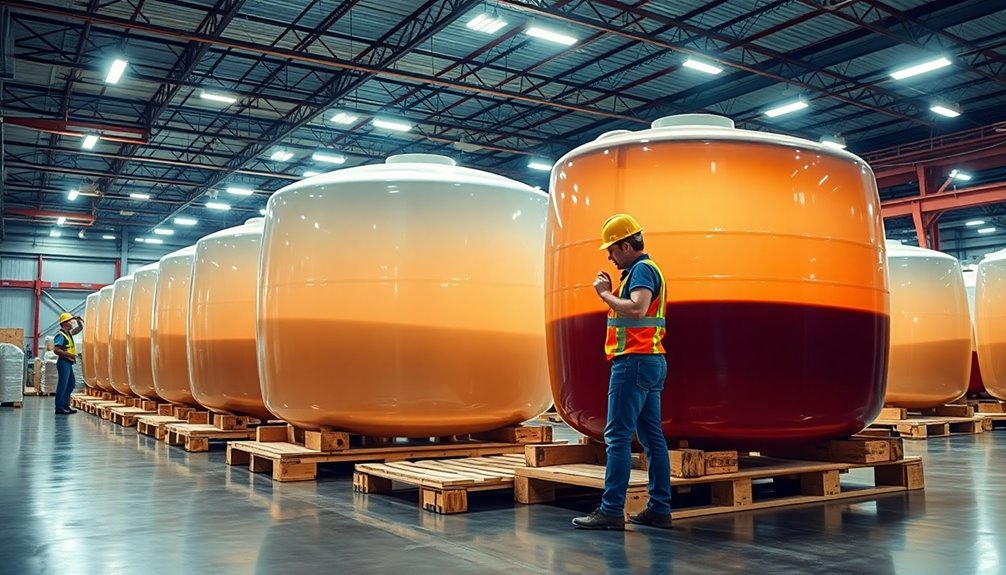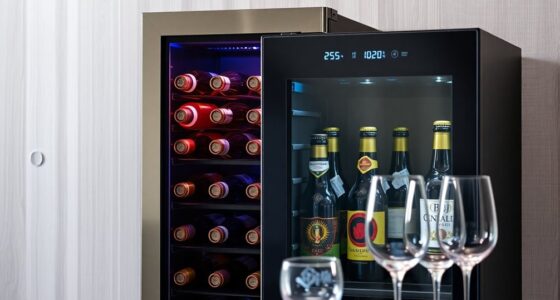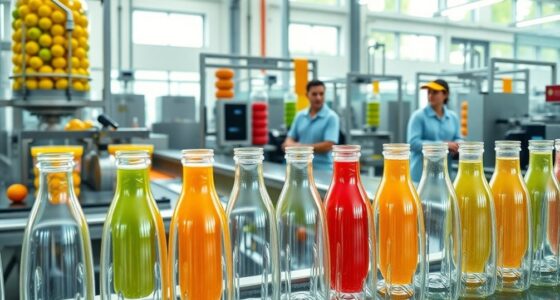Liquid logistics is essential for safely storing and transporting various liquids. To optimize space and reduce environmental impact, consider innovations like flexitanks, which can hold up to 24,000 liters. Using appropriate packing materials, clear labeling, and secure seals helps prevent leaks and contamination risks. Regular inspections and safety protocols guarantee compliance and minimize risks. If you're keen to discover more innovative approaches and solutions for liquid packing, there's much more to explore!
Key Takeaways
- Utilize customized flexitanks for efficient storage, capable of holding up to 24,000 liters of non-hazardous liquids while minimizing carbon emissions.
- Implement Bag in Box containers for safe dispensing, reducing oxidation and enhancing liquid preservation during transport.
- Incorporate insulation liners to protect liquids from temperature fluctuations, ensuring product integrity throughout the shipping process.
- Use multi-layered packaging systems that prevent contamination and leakage, enhancing safety during transport of sensitive liquids.
- Adopt eco-friendly materials and practices, such as recycled packaging solutions, to reduce environmental impacts in liquid logistics.
Understanding the Importance of Liquid Logistics

Liquid logistics plays an essential role in today's economy, especially as you consider the growing demand for various liquid commodities. The transportation methods used for liquid products, like crude oil, chemicals, and beverages, require specialized handling and infrastructure.
With the global market for bulk liquids projected to grow by 5-7% annually, efficient logistics solutions are more important than ever. Innovations like flexitanks optimize space and reduce carbon emissions by up to 40%, showcasing the positive environmental impact of modern liquid logistics.
However, you must also prioritize regulatory compliance and risk management to navigate the complexities of transporting liquids across borders. By understanding these factors, you can guarantee the safe and efficient movement of valuable liquid products.
Key Considerations for Packing Liquids

When packing liquids, it's essential to start by consolidating and categorizing all items to minimize the risk of spills and damage during transport.
Make certain to use appropriate packing materials, like professional moving boxes with padding and secure seals, to enhance protection against leaks.
Always pack liquids in individual containers, ideally unopened and factory-sealed, as this helps maintain product integrity.
Clearly label all packed liquids for easy identification upon arrival, aiding in safer handling.
Additionally, familiarize yourself with regulations regarding prohibited liquids, such as flammable gases and toxic substances, to guarantee compliance and safety.
Consider using color accuracy techniques in your packing process to ensure that any labels or markings are easy to read and identify.
Innovative Packing Materials and Techniques

Innovation in packing materials and techniques has transformed the way liquids are stored and transported. Customized flexitanks made from durable polyethylene or polypropylene can hold up to 24,000 liters of non-hazardous liquids, maximizing container space and cutting shipping costs.
Packaging innovations like Bag in Box containers utilize a gravity dispensing system, minimizing air entry and oxidation, ensuring your liquids stay fresh. Insulation liners protect bottles during wine transport, shielding them from temperature fluctuations. These innovative packaging solutions not only enhance the protection of the liquids but also significantly extend their shelf life. By efficiently limiting exposure to oxygen and temperature variations, they maintain the quality of the contents for longer periods. Understanding the shelf life of beverages explained through such advancements helps consumers appreciate the importance of proper packaging for their favorite drinks.
Multi-layered systems enhance product integrity, preventing contamination while customizable valves make filling and discharging easy. Plus, lightweight designs like flexitanks lower fuel consumption, reducing the overall carbon footprint of your liquid logistics.
Embracing these innovative solutions can greatly enhance efficiency and sustainability in your operations.
Custom Solutions for Liquid Storage

When it comes to liquid storage, tailored packaging options can make all the difference in ensuring your products remain safe and intact.
You'll want to contemplate enhanced safety features that protect against contamination and leakage while maximizing efficiency.
Custom solutions not only streamline your logistics but also safeguard the integrity of your liquid goods.
Tailored Packaging Options
By utilizing solutions like flexitanks, you can store between 16,000 to 24,000 liters of non-hazardous bulk liquid, maximizing your shipping container space and cutting transportation costs.
Bag in Box (BIB) containers provide customizable taps and valves, catering to various densities and viscosities, making them versatile across industries.
Plus, these packaging options can be crafted from over 80% recycled materials, greatly reducing carbon emissions associated with liquid transport.
With specialized insulation liners for wine bottles, you can safeguard your products from temperature fluctuations, ensuring quality during transit.
Multi-layered flexitanks enhance protection against contamination and leakage, maintaining the integrity of your valuable liquids.
Additionally, employing renewable energy sources for production can further minimize the environmental impact of liquid logistics.
Enhanced Safety Features
Tailored packaging options not only enhance efficiency but also prioritize safety in liquid storage solutions.
Customized valve options allow for easy filling and discharge, greatly reducing the risk of spills and leaks during transportation.
Multi-layer protective designs in flexible containers guarantee product integrity by preventing contamination and maintaining stable temperatures.
You can also integrate accessories for temperature monitoring and liquid stabilization, essential for sensitive liquids in transit.
Advanced sealing techniques and compatibility assessments of packaging materials further minimize leakage risks.
Additionally, anti-static coatings and spill prevention systems contribute to risk management, especially when transporting volatile or hazardous liquids.
Environmental Impact of Liquid Transportation

When you consider the environmental impact of liquid transportation, it's clear that reducing carbon footprints is essential.
By adopting sustainable packaging solutions and eco-friendly transport practices, you can make a significant difference.
Innovations like flexitanks and biodegradable materials are just a few ways to enhance efficiency while protecting the planet.
Carbon Footprint Reduction
Reducing the carbon footprint of liquid transportation is essential in today's environmentally conscious world. By adopting flexitank technology, you can cut carbon emissions by up to 40%, saving around 2kg of CO2 per kilometer traveled.
Packaging solutions made from over 80% recycled materials also play a crucial role, as they can be recycled with minimal recovery costs.
Additionally, the efficient design of box-shaped bulk containers minimizes excess space, leading to better assembly on pallets and reduced fuel consumption during shipping.
The lightweight nature of flexitanks further enhances sustainability, lowering overall fuel needs compared to traditional methods.
Sustainable Packaging Solutions
Sustainable packaging solutions are essential for minimizing the environmental impact of liquid transportation while maintaining efficiency.
By choosing innovative options, you can greatly reduce your carbon footprint and improve product quality during transit.
- Use flexitanks to convert standard shipping containers into bulk liquid transport vessels, cutting carbon emissions by up to 40%.
- Opt for Bag in Box containers, which are recyclable and minimize excess space for transport.
- Incorporate lightweight packaging designs to lower fuel consumption.
- Explore biodegradable materials and improved sealing technologies for better sustainability.
- Utilize materials made from over 80% recycled content to reduce production-related emissions.
Eco-Friendly Transport Practices
As the demand for liquid transportation grows, adopting eco-friendly transport practices becomes essential for minimizing environmental impact.
You can notably reduce carbon emissions by utilizing flexitank technology, which can lower emissions by up to 40%. Choosing packaging made from over 80% recycled materials not only cuts waste but also lowers your carbon footprint in the transportation of liquids.
Lightweight flexitanks replace traditional drums and IBCs, optimizing space in shipping containers and reducing costs. Implementing gravity dispensing systems helps prevent air entry, ensuring your liquids stay fresh while minimizing waste.
Finally, efficiently assembling box-shaped containers on transport pallets maximizes space utilization, contributing to more sustainable logistics practices.
Embrace these strategies to enhance your eco-friendly transport efforts.
Safety Protocols for Liquid Handling

When handling liquids, it's essential to establish rigorous safety protocols to prevent accidents and confirm compliance with regulations.
Here are key practices to take into account:
- Verify containers are securely sealed to prevent leakage or spillage.
- Use compatible packaging materials to avoid harmful chemical reactions.
- Maintain proper load distribution for stability during transport.
- Conduct regular inspections of equipment and packaging to identify risks.
- Implement thorough safety training programs for your team.
Exploring Flexitanks and Their Advantages

Flexitanks offer a revolutionary solution for transporting non-hazardous liquids efficiently and cost-effectively.
Designed to fit inside standard shipping containers, these large, collapsible containers can hold between 16,000 and 24,000 liters of liquid in bulk. By maximizing container space, flexitanks considerably reduce shipping costs and eliminate the need for traditional packaging like drums.
They also feature multiple layers of protection, ensuring product integrity and preventing contamination during transit. With customizable valve options for easy filling and discharge, flexitanks adapt to your specific needs.
Their lightweight design contributes to lower fuel consumption, helping you minimize your carbon footprint in liquid logistics. Tailoring material selection and dimensions enhances protection, making flexitanks an excellent choice for transporting various liquids.
Challenges in Liquid Logistics and Solutions

While transporting liquids can seem straightforward, several challenges complicate the process, from temperature fluctuations to contamination risks.
To navigate these challenges in liquid logistics, it's crucial to implement effective management solutions. Here are some key considerations:
- Temperature control systems to prevent oxidation.
- Insulation liners for bottled wine to combat container rain.
- Understanding compliance for international shipments, especially for wine.
- Innovations like flexitank technology for bulk liquids.
- Proactive climate condition assessments to maintain product integrity.
Future Trends in Liquid Packing and Storage

As the demand for liquid logistics evolves, you'll find that future trends are increasingly focused on sustainability and efficiency.
The shift towards biodegradable and recyclable materials in liquid packing is helping reduce environmental impact across the supply chain.
Innovations like flexitank technology allow you to ship up to 24,000 liters of various types of liquid in standard shipping containers, enhancing shipping efficiency while cutting emissions by up to 40%.
Additionally, IoT integration enables real-time monitoring during transport, ensuring safety and quality control.
Advances in packaging design, including insulation liners, are essential for protecting sensitive liquids, such as wine, from temperature fluctuations and light exposure.
The trend toward bulk shipping, especially in the wine industry, signals a significant growth in logistics practices. Furthermore, utilizing energy-efficient models in temperature-sensitive liquid logistics can significantly minimize the carbon footprint associated with transportation.
Frequently Asked Questions
What Is the Best Way to Transport Liquids?
To transport liquids safely, start by categorizing them based on their properties.
Use high-quality packing materials like professional moving boxes and protective padding to prevent leaks.
If you're dealing with sensitive items, consider temperature-stabilizing insulation liners to guard against extreme conditions.
Always check regulations to guarantee compliance with prohibited substances.
Finally, using flexitanks can optimize space in shipping containers, making your transport process more efficient and effective.
How Do You Pack Liquid Containers?
Packing liquid containers isn't just about shoving them into boxes; it's a careful balance of organization and safety.
Start by gathering all your liquids in one spot, categorizing them for easy access. Secure openings with plastic wrap to prevent leaks, and always label everything clearly.
Discard any opened liquids to avoid spills, while factory-sealed containers can safely go into your moving boxes.
What Container for Transporting Liquid?
When transporting liquids, you'll want to choose a container that suits your specific needs.
Flexitanks are great for bulk non-hazardous liquids, maximizing space in standard shipping containers.
If you're dealing with hazardous materials, ISO tanks provide secure transport due to their robust design.
For smaller quantities, Bag in Box containers are versatile and protect against oxidation.
Always consider the size and shape of the container to guarantee safety and efficiency during transport.
Will Movers Pack Liquids?
Imagine you're moving and decide to pack your favorite scented candle.
Movers usually won't pack liquids because of the risk of spills that can damage your other belongings. They often advise against transporting opened liquids, like cleaning supplies, and suggest disposing of them instead.
Additionally, some liquids can be hazardous, making them illegal to transport.
Conclusion
As you navigate the ever-evolving landscape of liquid logistics, picture a world where innovation flows as smoothly as the liquids you transport. By embracing cutting-edge packing materials and sustainable practices, you're not just optimizing efficiency; you're also safeguarding our planet's future. With each carefully packed container, you're weaving a tapestry of reliability and safety. So, seize the opportunity to redefine liquid storage and packing, and let your operations ripple with success in this dynamic industry.
Cindy thoroughly researches juicing trends, techniques, and recipes to provide readers with practical advice and inspiration. Her writing style is accessible, engaging, and designed to make complex concepts easy to understand. Cindy’s dedication to promoting the advantages of juicing shines through her work, empowering readers to make positive changes in their lives through the simple act of juicing.











